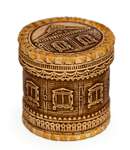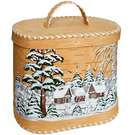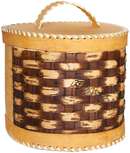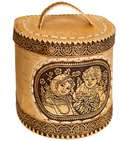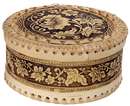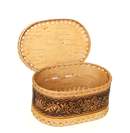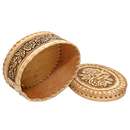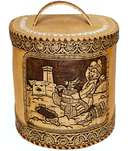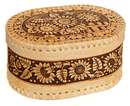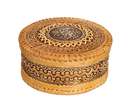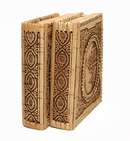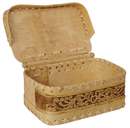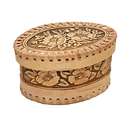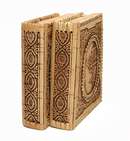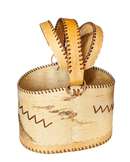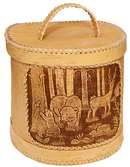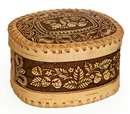Boxes & Bread Boxes
Keep your bread fresh in these all natural, easy to open bread boxes. Made from birch Bark, they add tasteful style to a kitchen.
Open top baskets and trays made of birch bark will keep your fruits fresh. Great for candies as well.It would be appropriate here to mention one more type of birch bark art. This type of carving is done with chisels of all different profiles, either using a cutting knife, or skipping on it altogether. This method serves for highly interesting ornamental designs resulting from a multi-layered approach to carving. Multi-layering means that one layer is carved under another layer of bark. Multi-layered scrollwork is a modern technique, not known by our ancestors.
In the past wood carving was differentiated by regions. It was impossible to mistake the Northern scrollwork from that done in the Urals. But today many methods of birch bark art are simply lost. That’s why, perhaps, the market visibility of hand-made birch bark crafts has been on the decline in recent years. A remarkably common characteristic of contemporary design painted items made of birch bark is that nowadays artists do not cover the entire surface with paint first, like it was done in the past. Nowadays, the golden tint of the natural untreated bark is left to shine through, with decorative painting applied right over it.
Birch weaving has stayed pretty much the same since antiquity. It is aesthetically pleasing to look at various birch bark items, such as wicker boxes, salt shakers, jewel cases, candy bowls and pencil holders. But time has brought changes here too. Bulky birch bark shoulder bags are practically not produced any more, ditto for baskets, hampers and large trunks. Thick bark is almost never used now, everything produced currently is of a small souvenir quality, sometimes achieving almost pocket-size status.
This trend is common to the whole industry, not only the wicker business. Things made of birch bark are not used in households on any large scale. Instead, birch bark provides material for souvenirs. Our ancestors had a priority for the functional use of birch bark, we, on the other hand, find its aesthetic qualities more important. That’s why the production of jewelry items, almost non-existent before, is now on the increase. Birch bark pins, bracelets, charms and pendants, or even headbands are all made as pretty as can be, sometimes incorporating gem stones. In general, birch bark articles have become an embodiment of Russian style. They remind one of the times gone by, and of the urge to move ahead into the Golden Age, which has either already happened, or still has to be. The Golden Age of the Birch Bark, that’s something to strive for! Items made of birch bark can be viewed as a secure talisman against the aggressive plastic civilization of today.
It is appropriate here to talk about our company. We have moved on from the production of birch bark tableware to the production of souvenirs and jewelry items. It is the latter that constitutes now the majority of our stock. Ceiling pendants ‘Siberian Bird of Happiness’, architectural compositions, carved Easter eggs, all these are made on the basis of a one-layer scrollwork, omitting any glue under it. This way it all looks fragile, cellular, aerial. Tiny houses made of birch bark can make up a fascinating toy city.
An interesting effect is achieved by covering dark glass with a layer of birch bark. The resulting contrast of glass and bark colors and texture creates an eloquent effect. That serves as the basis for making decorative bottles encrusted with birch bark. We glue a carved tissue of birch bark onto the bottle from both sides. On the inside the bark tissue shines through the glass, creating a unique shadow play. One gets an sense of fullness and a 3D effect.
The idea to use printed or stained birch bark as a veneer for antique boat models came into view and got our attention. The veneer made of birch bark imitates old ships made of darkened oak wood. They look like as if about to set off powdered by birch bark sails.
One more direction on our workshop floor is the production of birch bark souvenir tailor thimbles. Thimble collection is an established line of professional or hobby collection. All sorts of precious metals, china bone, and ivory are used in beautifying collector’s thimbles. We make thimbles from birch bark and plain wood. For ornamentation sometimes we choose images of ancient cities, or nature, or we choose for a laced design. With all that, we don’t forget about lidded baskets and containers. We have learned the technique of fine lace-like scrollwork and embossing. Later on, when we saw how many small, but very pretty pieces are left as a waste product in the processing of the bark, we got the idea of a patchwork method. We glue multiple pieces of loose bark tissue, all different as for color and texture, to the top layer of a birch bark container, and then connect these individual pieces together with bark stapler-like stiches using a decorative stitch line. Some pieces are subjected to fine scrollwork or embossing for extra flourish. The final slightly cylindrical container is a beautiful, cozy-looking article which will add grace to any interior.
Let me talk a little about the inner bark of the birch tree. The inner bark is used to make the inner lining of a birch bark container, sealing it hermetically. It is normally taken off a fallen trunk in one piece. In the olden times, lumbermen would peel thousands of inner bark strips while cutting down birch trees. Now using the inner bark is almost unheard off. Most masters of today use bark sheets for both the inner and the outer side of a container, locking the edges together with a stitch. Some people don’t even try to stitch the bark, using glue and support molds instead. Those who still bother to get the inner bark seem rather bashful in our days - girdling is a difficult chore. One experiences a sort of jealous admiration towards these people. It would have been fantastic, if one could just go to the woods like the legendary Grandfather Martijn, and fell down a birch tree, peel the inner bark off of the tree, steam it up and spread it flat out. To be able to do everything in an old traditional way would be a great experience. So much so, that I personally don’t even feel like a real master without ever having done it myself.
There are some uses of birch bark appearing now which would not have been popular before. Like making a pillow… A pillow is made and then stuffed with the smallest birch bark flakes. It is said that a pillow like that has healing properties. It is for sure incredibly soft and pleasing to sleep upon.
Mother Earth, your birch trees nurtured me,
In turn, I cared for them during heavy storms
So my great motherland can keep on dreaming
The white birch tree – it’s a sight that adorns.
(G. Ferre, The Birch Song)
Our artisan ancestors worked only with the best quality bark. The standard piece was attractive, even shaped and had a smooth surface. Only the yellow side of the bark, the side turned inwards to the core of the tree, was used in the making of household articles. Time has brought changes in this respect too. We, at the present time, are attracted mostly by things which our grandfathers considered superfluous, the nodes, the white side, all the various defects which make the bark even more interesting and attractive to the modern eye.
Sometimes, with the right treatment one can use the bark taken off decayed trees, or bark tissue that has been soaking in water for a long time. Small pieces of birch bark can be gathered this way at river banks after timber had been rafted. Such pieces are shiny, of black or silver-grey color. Artists use pieces like that to create compositions, or use it as canvas for small paintings.
So, now that I have told you a little about the current state of birch bark business, I should add that my story covered only the Russian traditional use. There are other populations living in Yakut and Buryat lands, as well as further up in the North and in the Far East, who have their own, distinctively different ways of treating birch bark. New times bring new approaches. The old rustic creations have provided the basis for a professional artisan art, and the birch bark business is alive and thriving.



